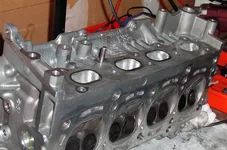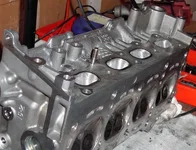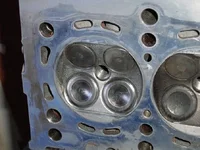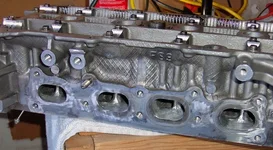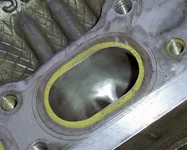flat_black
Member
Well, since I'm burning oil like crazy, I pulled my old head, and plopped on my spare. Anyway, that's fine. The valve seals aren't as far gone as the ones on the head that has now become my spare. The spare had undergone some light porting, polished exhaust runners and CCed chambers, been deburred, and chamfered the coolant and oil passages, blah-blah-blah.
So, now I have this head sitting on my bench, going under the knife. It'll be put to the same stresses, only this one is getting a new set of lightened valves, a new set of Eibach valve springs, Toga valve seals and bronze valve guides to accomidate the lightened stainless valves. Titanium retainers, and new keepers. It'll be hot tanked, and I'll have the quenches welded up by DPR.
Right now, I've gotten as far as is shown in the pictures below, and I've ported the intake side, too. I still have yet to polish the exhaust side, but I'm planning on working on that tomorrow. I'm going to remove the stock valves once I get a new spring compressor (Old one got lost durring the move... Any suggestions on a new one?), and will do a preliminary cleaning. As it is, I cleaned off all the gasket surfaces, and the intake/exhaust mating surfaces will be lapped true at the same time that I get the head milled down about .010" to true.
If all goes as planned, I should have this done by later this year/early-early next year, as the work done by DPR will cost me a chunk of money, as well as the cost for the springs ($250), valve seals ($60), the valve guides (TBA), and the valves ($350-400).
Without any further ado, here are the pics.
So, now I have this head sitting on my bench, going under the knife. It'll be put to the same stresses, only this one is getting a new set of lightened valves, a new set of Eibach valve springs, Toga valve seals and bronze valve guides to accomidate the lightened stainless valves. Titanium retainers, and new keepers. It'll be hot tanked, and I'll have the quenches welded up by DPR.
Right now, I've gotten as far as is shown in the pictures below, and I've ported the intake side, too. I still have yet to polish the exhaust side, but I'm planning on working on that tomorrow. I'm going to remove the stock valves once I get a new spring compressor (Old one got lost durring the move... Any suggestions on a new one?), and will do a preliminary cleaning. As it is, I cleaned off all the gasket surfaces, and the intake/exhaust mating surfaces will be lapped true at the same time that I get the head milled down about .010" to true.
If all goes as planned, I should have this done by later this year/early-early next year, as the work done by DPR will cost me a chunk of money, as well as the cost for the springs ($250), valve seals ($60), the valve guides (TBA), and the valves ($350-400).
Without any further ado, here are the pics.

